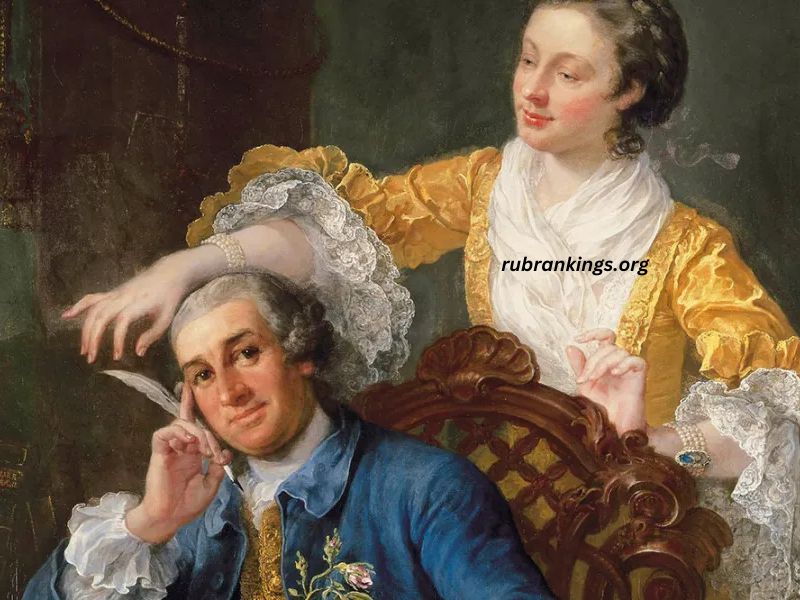Step into the rich world of 18th-century art and culture as we explore William Hogarth’s remarkable portrait of David Garrick and his wife, Eva-Maria Veigel. Join us as we uncover the story behind this celebrated painting, understand its artistic brilliance, and reveal its impact on art, history, and theater.
William Hogarth: The Art Revolutionary
William Hogarth, an iconic figure of 18th-century art, was more than just a painter—he was a storyteller, a satirist, and a visual historian. His works went beyond surface beauty to capture the bustling essence of Georgian society. Known for his innovative engravings such as A Rake’s Progress and Gin Lane, Hogarth was a master at weaving narratives into his art, challenging societal norms while remaining accessible to a broad audience.
Hogarth’s work frequently transcended mere portraiture, bringing his subjects to life with dynamic settings and a spark of individuality. Among his treasured pieces is the famous portrait of David Garrick and Eva-Maria Veigel—an artwork that wonderfully showcases Hogarth’s mastery of combining artistry with storytelling.
A Glimpse into the World of David Garrick and Eva-Maria Veigel
David Garrick, one of the most celebrated actors of the 18th century, was a true superstar of his time. Known for his versatile acting skills and for revitalizing Shakespearean plays, Garrick was instrumental in shaping the theater world. His wife, Eva-Maria Veigel, was no less fascinating. A dancer of Austrian origin, Eva-Maria—or “La Violette,” as she was known professionally—had a thriving career as a performer before marrying Garrick.
Their love story was nothing short of captivating. Despite her family’s apprehension about an actor as a partner, Eva-Maria married Garrick in 1749, creating a dynamic union that exuded both creativity and charm. The couple became the centerpiece of Hogarth’s now-classic painting, uniting theater, dance, and art on a single canvas.
Decoding the Masterpiece
Hogarth’s Portrait of David Garrick and His Wife serves as a visual narrative, masterfully blending artistry and deeper meaning. Here’s a look at its key elements:
The Composition
The painting captures the Garricks in an intimate yet theatrical moment—David seated and pen in hand, while Eva playfully attempts to snatch it away. The composition exudes balance, with the couple’s elegant poses framed by pastoral elements in the background. Together, they create a harmonious blend of domesticity and performance.
The Style
Hogarth’s skill in portraiture shines through in the lifelike expressions and intricate details. From Eva-Maria’s delicate gown to David’s animated gaze, every element feels alive. Hogarth’s signature realism is given a touch of theatricality, paying homage to Garrick’s world of drama.
The Narrative
This is no ordinary portrait—it’s a witty portrayal of their dynamic relationship. Garrick’s writing symbolizes his literary contributions to theater, while Eva playfully disrupts, adding a lighthearted charm. Hogarth skillfully intertwines their love, creativity, and individuality.
The Symbolism
Behind the humor lies rich symbolism. The quill represents Garrick’s devotion to the written word, while Eva-Maria’s lively gesture underscores their partnership’s playfulness and balance. These subtle elements invite the viewer to imagine the story of their lives.
The Cultural Context
The 18th-century art scene was defined by its celebration of wit, intellect, and social commentary—Hogarth’s body of work epitomized these ideals. This portrait isn’t only about the Garricks but also speaks to the broader themes of celebrity culture and artistic identity during their time.
The Garricks were considered a true power couple, embodying the heights of Georgian fame. Garrick’s unprecedented success on stage—combined with Eva-Maria’s graceful transition from dancer to admired socialite—represented the aspirational values of the era. Hogarth, a contemporary of the Garricks, brilliantly taps into their cultural significance, immortalizing them as figures of sophisticated artistry.
A Lasting Impression
What makes Garrick and His Wife truly timeless is its far-reaching influence. It stands as a testament to Hogarth’s ability to infuse art with narrative and personality, inspiring countless artists to blend storytelling into portraiture.
This piece also serves as an enduring reminder of the intersection of art and performance. Modern artists and enthusiasts continue to study its dynamic composition, creative storytelling, and cultural relevance, keeping its significance alive centuries later.
An Invitation to Discover More
Hogarth’s Portrait of Garrick and His Wife is more than just a painting—it’s a window into 18th-century life, a celebration of talent, and a testament to the power of storytelling through art. Whether you’re a seasoned art admirer, history enthusiast, or passionate theatergoer, it’s a masterpiece that invites endless exploration.
Are you curious to see this work or others like it in person? Plan a visit to a gallery that showcases Hogarth’s works or explore additional resources to deepen your understanding of his artistry. We’d love to hear your thoughts—share your impressions in the comments below! Don’t forget to browse our website for more articles on captivating artworks and their fascinating histories.



